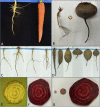Form and contour: breeding and genetics of organ shape from wild relatives to modern vegetable crops
- PMID: 37841632
- PMCID: PMC10568141
- DOI: 10.3389/fpls.2023.1257707
Form and contour: breeding and genetics of organ shape from wild relatives to modern vegetable crops
Abstract
Shape is a primary determinant of consumer preference for many horticultural crops and it is also associated with many aspects of marketing, harvest mechanics, and postharvest handling. Perceptions of quality and preference often map to specific shapes of fruits, tubers, leaves, flowers, roots, and other plant organs. As a result, humans have greatly expanded the palette of shapes available for horticultural crops, in many cases creating a series of market classes where particular shapes predominate. Crop wild relatives possess organs shaped by natural selection, while domesticated species possess organs shaped by human desires. Selection for visually-pleasing shapes in vegetable crops resulted from a number of opportunistic factors, including modification of supernumerary cambia, allelic variation at loci that control fundamental processes such as cell division, cell elongation, transposon-mediated variation, and partitioning of photosynthate. Genes that control cell division patterning may be universal shape regulators in horticultural crops, influencing the form of fruits, tubers, and grains in disparate species. Crop wild relatives are often considered less relevant for modern breeding efforts when it comes to characteristics such as shape, however this view may be unnecessarily limiting. Useful allelic variation in wild species may not have been examined or exploited with respect to shape modifications, and newly emergent information on key genes and proteins may provide additional opportunities to regulate the form and contour of vegetable crops.
Keywords: IQD/SUNs; OVATE Family Proteins; TONNEAU1 Recruiting Motif (TRM) family; digital imaging; fruit shape; market class; root shape; universal shape regulators.
Copyright © 2023 Goldman, Wang, Alfaro, Brainard, Oravec, McGregor and van der Knaap.
Conflict of interest statement
The authors declare that the research was conducted in the absence of any commercial or financial relationships that could be construed as a potential conflict of interest. The handling editor RO declared a past co-authorship with the author IG.
Figures




References
Publication types
LinkOut - more resources
Full Text Sources
Research Materials

